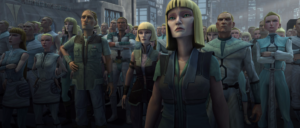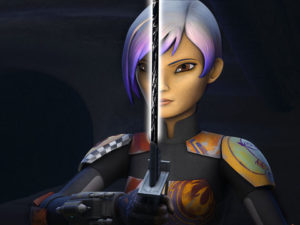 When it comes to being a Mandalorian fan, I could probably be considered a late bloomer. I didn’t really find any appreciation for them until I was 16 and discovered the Republic Commando books. At the time, only the first two had been released but those two were all it took for me to fall in love with first this batch of clones and then with the Mandalorian culture that Karen Traviss created. When you’re a sucker for found family stories, it was hard not to. That was not, however, the Mandalore we saw first in The Clone Wars and that is now the official canon. While I’m not the sort to be a bitter Legends fan, I strongly believe the Star Wars universe is lesser for it.
When it comes to being a Mandalorian fan, I could probably be considered a late bloomer. I didn’t really find any appreciation for them until I was 16 and discovered the Republic Commando books. At the time, only the first two had been released but those two were all it took for me to fall in love with first this batch of clones and then with the Mandalorian culture that Karen Traviss created. When you’re a sucker for found family stories, it was hard not to. That was not, however, the Mandalore we saw first in The Clone Wars and that is now the official canon. While I’m not the sort to be a bitter Legends fan, I strongly believe the Star Wars universe is lesser for it.
 The Mandalorians that I and so many others fell in love with were so much more than just cool armor although their armor was certainly a crucial part of who they were. Plates and pieces would often be passed down or given to close friends and each Mandalorian painted their armor as an expression of self and clan with colors meaning something. Blood wasn’t as important to them as culture, something that rang particularly true for me because of my own cultural background. There’s a word in Mando’a: dar’manda. It translates to “not Mandalorian” and doesn’t refer to those who are outsiders (that’s aruetii, by the way) but rather to those who’ve lost their heritage and therefore their soul. They were a group that valued clan and family but would happily adopt others into their way of life. It was found family to an extreme. I still get a little emotional over Kal Skirata formally adopting as many of his clone commandos as he could, including their loved ones.
The Mandalorians that I and so many others fell in love with were so much more than just cool armor although their armor was certainly a crucial part of who they were. Plates and pieces would often be passed down or given to close friends and each Mandalorian painted their armor as an expression of self and clan with colors meaning something. Blood wasn’t as important to them as culture, something that rang particularly true for me because of my own cultural background. There’s a word in Mando’a: dar’manda. It translates to “not Mandalorian” and doesn’t refer to those who are outsiders (that’s aruetii, by the way) but rather to those who’ve lost their heritage and therefore their soul. They were a group that valued clan and family but would happily adopt others into their way of life. It was found family to an extreme. I still get a little emotional over Kal Skirata formally adopting as many of his clone commandos as he could, including their loved ones.
In canon now though… things are different. The Mandalore we saw in The Clone Wars wasn’t even remotely close to the Mandalore of old. This was a civilized group, not rural clans. Leaders now had noble sounding titles like Duchess and we never even saw Satine in armor; something that previously been fundamental to the Mandalorian way of life. Rebels may have recently talked about the importance of armor and how the plates are passed down from generation to generation but it almost feels too little too late. While the intent may have been to make them be more technologically advanced, it could have been done without turning a proud warrior culture into a bunch of pacifists.
 The most painfully glaring issue though is how white Mandalore suddenly looked. Star Wars has long struggled with diversity but there was simply no excuse for how pale and blonde the entire planet suddenly was. Again, Rebels has made strides trying to edge a little bit closer to the old culture but it almost undermines itself even as they show more Mandalorian people of color. Clan Wren may be Mandalorian but they are described as being conquered and brought into the group. By itself, that’s fine but when Mandalorians were previously whitewashed to the extreme? Not so much. In fact, the hint of colonialism is just a little too strong there. It was like something punched me in the gut when we saw more racial diversity in addition to the Wrens amongst the clans but then they all promptly bent to the knee as Sabine gave the darksaber to Bo Katan. In a vacuum, watching a proud warrior culture bow to her isn’t a big deal but within the grander context, it’s not great from a diversity point of view.
The most painfully glaring issue though is how white Mandalore suddenly looked. Star Wars has long struggled with diversity but there was simply no excuse for how pale and blonde the entire planet suddenly was. Again, Rebels has made strides trying to edge a little bit closer to the old culture but it almost undermines itself even as they show more Mandalorian people of color. Clan Wren may be Mandalorian but they are described as being conquered and brought into the group. By itself, that’s fine but when Mandalorians were previously whitewashed to the extreme? Not so much. In fact, the hint of colonialism is just a little too strong there. It was like something punched me in the gut when we saw more racial diversity in addition to the Wrens amongst the clans but then they all promptly bent to the knee as Sabine gave the darksaber to Bo Katan. In a vacuum, watching a proud warrior culture bow to her isn’t a big deal but within the grander context, it’s not great from a diversity point of view.
It’s difficult to discuss Mandalorians without also mentioning the clone troopers who all originated from Jango Fett. Traviss found a great way to incorporate Temuera Morrison’s Maori background into Mandalorian culture and gave them a version of the haka: Dha Werda Verda. It helped make the clones feel more tied to Jango/Temuera in a way that the (let’s face it) increasingly white looking clones in canon just don’t. It was a big deal in 2002 when we saw that one of the most popular secondary characters in the saga was actually a person of color underneath his helmet and literature that leaned into and embraced this was all the stronger for it. The Clone Wars may have let us get to know the clones under their helmets in a way that non-EU readers hadn’t before and it is beyond awesome how Captain Rex has become a fan favorite but was it really worth the cost?
I do feel it’s important to note that this isn’t dislike for Satine. I think she’s an interesting character and her plot line and history with Obi-Wan were really neat but as a Mandalorian? Not so much. It’s also important to say that I am not trying to in any way undermine the importance of Sabine Wren and her family. Sabine was one of the first times that I saw myself represented on screen in Star Wars and I have repeatedly stressed the importance of characters like her. (Who would have ever guessed ten years ago that we’d be getting a technologically brilliant girl who’s also an artist and who is a woman of color?)
 While Rebels may being making strides towards trying to make the Mandalorians more diverse, it is hard to do so when their starting point is a snow white society especially when that version of Mandalore erased a more diverse group. Family is clearly important to every iteration of Mandalorians but that lost emphasis on found family and culture is sorely missed. If Sabine had been the one to raise the darksaber and take the title of Mandalore, so much of the episode would have played differently for me emotionally. Who knows? Perhaps that may still happen in this final season of Star Wars Rebels but until it does? (If it ever does)
While Rebels may being making strides towards trying to make the Mandalorians more diverse, it is hard to do so when their starting point is a snow white society especially when that version of Mandalore erased a more diverse group. Family is clearly important to every iteration of Mandalorians but that lost emphasis on found family and culture is sorely missed. If Sabine had been the one to raise the darksaber and take the title of Mandalore, so much of the episode would have played differently for me emotionally. Who knows? Perhaps that may still happen in this final season of Star Wars Rebels but until it does? (If it ever does)
Sorry canon Mandalorians: our relationship status is officially stuck at “it’s complicated.”


I love this so much. On my tumblr, I already rant about how much I hated the new mandalorian society, and the lack of diversity/white washing. On top of that, the huge implications of white imperialism/colonialism that was supported and praised galaxy wide was just sad. The Mandalore in the clone wars was not the Mandalore many were used to. It just screamed so many bad implications and like many people have stated, Mandalore was a diverse culture. It isn’t meant to be white washed, and seen as a monarchy.
But one part I love that you mentioned is your discomfort seeing the Mandalorians bow to Bo-Katan at the end. Especially since Bo-Katan made the comment, “I take this saber for my sister”, in front of all of the people Satine had banished and eradicated to make way for her own view of the culture.
As a woman of color myself, it would have been so powerful for me to see Sabine take the saber, because no one can deny that SHE was the one who united Mandalore in Rebels, if it weren’t for her they would not have gotten to that point. I fully believe that she deserved it. Not Bo-Katan because while I love Bo, her getting the saber makes it seem like Mandalore is now a monarchy, and the saber must be passed on in the Kryze line. It’s almost as if she was expected to get it, despite Sabine proving herself.
Anyway, I love this article. It resonates so much with me. And the fact that you mentioned the clones really makes me happy, because I love them being connected to Mandalorian culture, despite the fact that in The Clone Wars, the Fett’s weren’t seen as Mandalorians and neither were the clones. But the Fett’s and clones WERE mandalorians.
Also, while this may not be worth mentioning, the introduction of Satine and the New Mandalorians actually made the fandom even more dangerous and racist toward mando fans who were poc. The terrible implications that only pale white people could be Mnadlorians had it’s consequences.
But anyway, I loved this. It sent to me on tumblr! It was a nice morning read.
You should read this.
eleven-thirtyeight.com/2017/10/for-mandalore-the-escalation-of-drama-and-subversion-of-expectations/
And honestly, I feel like Rebels more than made up for TCW’s Mando whitewashing.